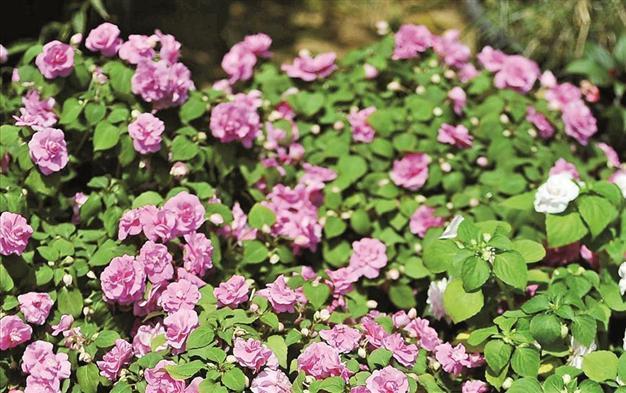Don’t Eat My Flowers!
Aylin Öney TAN - aylin.tan@hdn.com.tr

AA photo
I love flowers but I seldom have them in a vase at home. I do not grow pots of violets or have impressive roses in my garden. Never cared for a bouquet, actually never received a decent pretty one from a man. I definitely do not have a green finger. Don’t get me wrong, I do care for flowers, but on my plate. I like to eat them!The month of May surely belongs to flowers. When May comes the spring is in full bloom, and summer days practically begin. In the old times the spring festival of Hıdırellez on May 5th used to mark the start of summer. In the folk calendar the year was split into summer and winter days, and 186 days of summer started from May 5th lasting till 8th of November when winter began. This was pretty much the same yearly pattern of the Celtic calendar where Beltane festival marks the start of summer. May Day is practically the old Pagan spring festival and of course flowers of all sorts are symbols of all such festivals worldwide.
My own personal culinary quest of eating flowers started when living in Algiers, my house just near a beautiful orange grove. The faint scent of orange flowers made me obsessed with the idea of using them in the kitchen. I was soon making phenomenal jams and sublime puddings with all citrus flowers, but my ultimate creation proved to be crystallizing the tender petals. My passion for eating flowers did not stop by the boundaries of the orange grove, I soon became obsessed with crystallizing almost all flowers that were edible. The end of this flowery adventure came to a halt when my neighbor put a sign in front of her garden simply saying: “Don’t Eat My Flowers!” The message was taken, spring was almost over anyway, so I stopped assaulting the neighboring gardens. But since then my interest in edible flowers has remained.
The culinary use of flowers in Turkish cuisine is a rather unexplored area though its roots date back to ancient times. The Hittites used to celebrate the awakening of nature by the spring festival of AN-TAH-SUM-SAR, which was the Hittite word for crocus, naming the festivities. After years of research scholars concluded that the “SAR” suffix indicated a bulbous plant, and the flower honoring the rite of spring should have been the crocus. It is quite astonishing to see that after almost 4,000 years the tradition still survives in rural villages of Anatolia such as Çorum and Sivas. Every spring, the children are sent to the fields to look for crocus flowers, which they dig out the flower together with the bulb, and decorate a bare branch, pretending that it has just bloomed and walk from house to house chanting and gathering food like bulgur, butter, salt and pepper. Eventually all the villagers follow the children and gather in a place to cook a communal bulgur pilaf, çiğdem pilavı, made with the cracked wheat and crocus flowers and bulbs. The crocus pilaf is like the official opening dish of the spring. The use of crocus bulbs is also very common in the legendary Gaziantep cuisine with numerous stews. There is even a milk pudding where smashed bulbs act as a thickening agent.
Of course crocus is not the only flower eaten in Turkey. The sweet delicacies like jams, desserts, hard candies and last but not least Turkish delight all make use of fragrant flowers such as roses, violets and orange flowers. Associating aromatic flowers with sweets is easy, but some flowers have a pungent, even spicy, flavor. However they can prove to be very useful perking up salads, like a splash of bright orange calendula petals giving a deep peppery note to any bland lettuce. And then there are the more obvious flowers we have on our tables on a daily basis such as the cauliflower and broccoli. Stuffed zucchini flowers of Aegean cuisine are becoming as popular as another stuffed flower, the artichoke!
Now it is the best time for artichokes and all other delicious flowers to devour. Decorate your spring table with flowers not in your vase but on your plate... The more you eat them the more springy you’ll be!
Recipe of the Week: The ultimate edible flower is of course the artichoke. I adore them fried whole, statuesque like a gilded sunflower. Take small, very tender artichoke heads, the pointed rose-like buds are better for this purpose. Cut the stem, try to open up the leaves trying to loosen them with your fingers, put the artichoke head upside down on the counter and bang the back with a ladle. The petals will be wide open like a flower. Scoop the hairy inside. Fry in deep oil until crisp and golden.
Bite of the week
Fork of the Week
Any artichoke dish that is made from fresh artichokes rather than the frozen stuff gets the prize, we
must exclude also the ones that have the annoying combination of cubed carrot & potato mix with
deadly canned peas. I totally despise the so-called creation with fancily squeezed fava puree nesting on the artichoke bottom like a misfortunate churros spiral. Try the more genuine artichoke dishes at Çiya in Kadıköy market, the rice stuffed one is very tasty; the oven baked version with lamb is really exciting.
Cork of the week
A floral rosé is what you need for a flowery May Day. The rosy news is that Turkey got three silver medals in the recent Rosé Wine competition in France. Le Mondial du Rosé 2013, organized by Oenologues de France between 20-22th April, hosted 28 countries represented by more than 1000 wines, almost 100 of them being sparkling varieties. The proud silver rosés of Turkey are: Suvla Kabatepe Blush 2012; Suvla Blush Cabernet Sauvignon 2012 and Kavaklıdere Rosato 2012.












